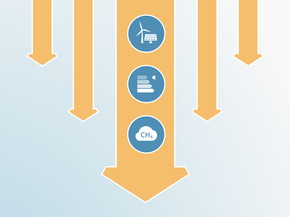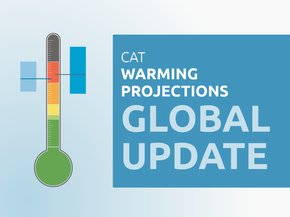Current Policy Projections
Economy-wide
Emissions in Mexico have continuously increased since 1990, with emissions shifting away from agriculture and LULUCF towards energy-related sectors. While agricultural emissions represented 31% of national emissions in 1990, by 2015 their share had declined to 18%. Over the same time period, energy-related emissions increased by almost 40%. It is worth noting that as of 2013, historical emissions as reported by the inventory are higher than the - already high - emissions projections under the NDC baseline.
Looking at Mexico’s current policies and taking into account the impact of COVID-19, we estimate that emissions will decrease in 2020 to between 664-696 MtCO2e per year, excluding LULUCF, which represents a 51-58% increase above 1990 levels, and 3-7% decrease below 2010 levels. We project that emissions will ramp up again as the economy recovers, climbing to up to 774-852 MtCO2e in 2030 (76-94% above 1990 levels and 19-31% above 2010 levels), excl. LULUCF.
We estimated a range based on the likelihood of implementation of major policies in the electricity, transport and buildings sectors (see the Assumptions section for more details). The upper end assumes that Mexico will not achieve the clean electricity targets set 50% by 2050 under the electricity policy “Prospectiva del Sector Eléctrico para 2017-2031”; while the lower end assumes that they will, its mitigation impact is taken as reported in the 6th National Communication (SEMARNAT, 2019a). In both cases, we assumed the mitigation potential of major transport and buildings policies would be achieved.
Under currently implemented policies, and even despite the dip in emissions expected for 2020 as a consequence of the pandemic, Mexico will not achieve its 2020 pledge. Our analysis also suggests that Mexico will need to implement additional policies to meet its unconditional and conditional NDC targets in 2030, although the lower bound of the current policy range gets very close to reaching Mexico’s insufficient unconditional NDC target.
The basis for climate policy in Mexico is its ‘General Climate Change Law’ (LGCC)—adopted in 2012—which translates the overarching targets into strategies and plans, and provides the institutional framework for implementation. The law does not include concrete political instruments, rendering it impossible to quantify its direct effects. The most recent reform to this law includes the addition of Mexico’s first NDC sectoral emission reduction targets for transport, electricity generation, buildings, oil & gas, industry, agriculture and waste sectors. The fact that the sectoral targets have been included in national legislation is now, unfortunately, being used as an argument against updating and increasing ambition of Mexico’s NDC in this new round, as argued by representatives of the Ministry of Environment during public consultations (SEMARNAT, 2020b).
Part of the institutional framework required by this law includes the development of a National Strategy on Climate Change, providing long-term planning, and a Special Programme on Climate Change (PECC) for the short-term planning. Mexico’s last National Strategy on Climate Change was published in 2013, and its last PECC in 2014. A third PECC has already been developed and approved by the Intergovernmental Climate Commission but second approval is needed by the Regulatory Body of Federal Government and Treasury (SEMARNAT, 2020a). It is expected to be published this year, covering the 2020-2024 timeframe. This document is to include short-term mitigation and adaptation goals per sector, as well as a list of concrete actions, budget and clear responsibilities at federal and state level to achieve the goals (Cámara de Diputados del H. Congreso de la Unión. Diario Oficial de la Federación, 2012; art. 67).
In 2014, Mexico implemented a carbon tax that is set at approximately at US$3.5/tCO2e differentiated by fuel type (SEMARNAT, 2014). This tax is expected to generate an annual revenue of about US$1 billion. However, its impact on GHG emission reduction is unclear and, given its low rate, a substantial emission reduction is unlikely. At the end of 2017, the regulation for the use of emission reduction credits for compliance under the carbon tax in Mexico came into force. This regulation establishes the allowance of Certified Emissions Reductions (CERs)—from CDM projects in Mexico—as well as Green Certified Emission Reductions—in the EU ETS—as payment means under the carbon tax (Diario Oficial de la Federación, 2017; World Bank Group and Ecofys, 2018).
In 2017, Mexico began a simulation of a voluntary Emissions Trading Scheme (ETS). The General Climate Change Law was amended later that year to make the scheme mandatory as soon as its three-year pilot phase concludes. The ETS will not replace the existing carbon tax and its pilot phase—originally programmed to start in August 2018—was planned to start operation in January 2020 (SEMARNAT, 2019b).
The preliminary regulations indicate that the emissions cap for the trial phase will be determined 30 days before its start based on the reported historical emissions of participants and Mexico’s NDC (SEMARNAT, 2019b). Defining the ETS cap on historical emissions puts the programme at risk of not achieving substantial emissions reductions. The cap should instead be set based on ambitious international climate commitments that are in line with the Paris Agreement goal.
Energy supply
Mexico’s government is taking a step backwards on climate in the energy sector by favouring fossil fuels over renewable energy generation. This includes the construction of a new oil refinery and a new budget allocation to the “modernisation” of coal, diesel, gas and oil-fuelled power plants, some of which the previous administration had already scheduled for retirement. Furthermore, a recently published energy bill effectively halts private renewable energy investment in the country, prioritising the government's own ageing, fossil-fuel power plants (Government of Mexico, 2020).
The Mexican government cited the coronavirus pandemic as a justification for the new bill, although in 2019 it had already started deprioritising the development of other renewable energy projects by also cancelling Mexico’s 2018 “Long-term electricity auctioning” round (Energia Estrategica, 2019). The scheme was introduced in 2015 as one of Mexico’s main instruments to achieve its clean energy targets under its Energy Transition Law and General Climate Change Law.
The decision to favour fossil fuel generation over renewable energy now puts Mexico on a path that is even more inconsistent with the steps it needs to take to achieve the Paris Agreement's 1.5°C limit. Its plans for the power sector stand in stark contrast to what is required to achieve the 1.5°C limit. The Mexican government’s recent decisions also bring into question whether it will achieve its clean energy targets under its Energy Transition Law and General Climate Change Law.
The Energy Transition Law (Cámara de Diputados del H. Congreso de la Unión. Diario Oficial de la Federación, 2015), published in December 2015, includes clean energy targets for Mexico for the year 2018 (25% of electricity generation), 2021 (30%) and 2024 (35%). Clean energy according to Mexican law includes renewable energy sources, nuclear power, CCS as well as efficient cogeneration (Congreso General de los Estados Unidos Mexicanos. Diario Oficial de la Federación, 2014).
President López Obrador´s campaign did not have a clear position on climate change, focusing instead on the energy sector. To increase electricity production, he proposes three actions: 1) increase the load factor of hydro power plants, 2) avoid the planned retirement of thermal—fossil fuel—power plants (by converting old ones to cogeneration and all units over 150 MW to gas CC) and 3) create programmes to foster energy transition to RE—solar PV, wind and hydro. Some of these proposals are now materialising, but little is left of the third promise to foster the energy transitions towards renewable energy sources. Most of the 2019 budget allocated to the Federal Electricity Company (CFE) was invested in the “modernisation” of coal, diesel, oil and gas power plants, some of which the previous administration had planned to retire.
In January 2019, Mexico’s government announced the cancellation of the 2018 long-term electricity auction (Centro Nacional de Control de Energía, 2019). This auction was intended to assign contracts for the trading of power, cumulative electric energy and clean energy certificates from 2021 onwards, but was suspended end of 2018 due to the change of government (Centro Nacional de Control de Energía, 2018a, 2018b). Furthermore, the government is using COVID-19 as a reason to further postpone the integration of renewables to the National Electrical System (Government of Mexico, 2020).
After fast-tracking permitting process, the construction of the “Dos Bocas” refinery in Tabasco started in June 2019 (Fanny Miranda, 2019). This project, together with López Obrador´s policy to foster fossil fuels in Mexico, has been heavily criticised by environmental groups nationally and internationally (Alberto Nájar, 2019). The criticism refers to concerns about climate change – going in the opposite direction of net-zero emissions – and concerns regarding safety, as the location is prone to hurricanes and flooding, as well as impacts on the local environment (CEMDA, 2019; Forbes, 2019).
Forestry
In its NDC, Mexico committed to unconditionally reduce GHG emissions from the forestry sector by 144% in 2030 from a BAU baseline (Government of Mexico, 2015). This means emissions going from 32 MtCO2e in 2030 under a baseline scenario, to -14 MtCO2e under the NDC scenario. Unlike the commitments on other sectors this commitment was not included in the July 2018 reform to the General Climate Change Law (Government of Mexico, 2015).
Mexico’s REDD+ National Strategy 2017-2030 (ENAREDD+) established strategic action lines with the aim of promoting continued reduction of LULUCF emissions and achieving 0% net deforestation rate by 2030 (CONAFOR, 2017).
Waste
In its NDC, Mexico committed to unconditionally reduce GHG emissions from the waste sector by 28% in 2030 from a BAU baseline (Government of Mexico, 2015). This commitment has been added to the General Climate Change Law in its July 2018 reform (Government of Mexico, 2015).
According to Mexico’s inventory data, emissions from the waste sector have gone from 12 MtCO2e to 43 MtCO2e between 1990 and 2015, making this sector the one with the highest emissions increase in this period.
Further analysis
Latest publications
Stay informed
Subscribe to our newsletter




